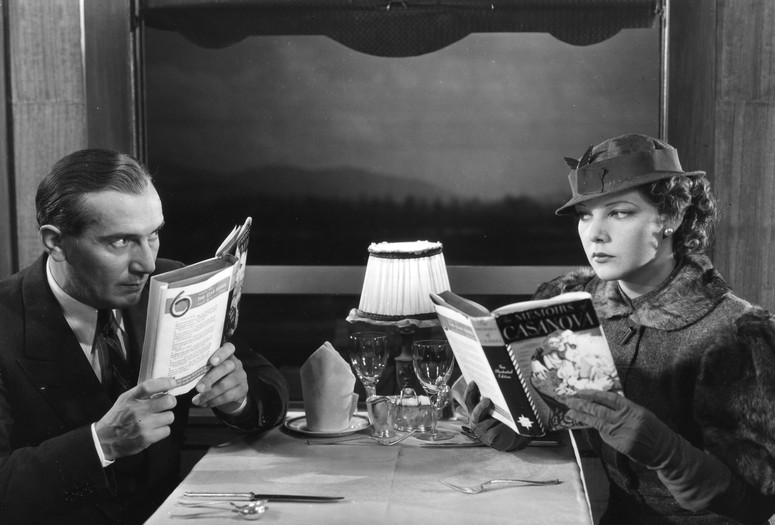It is the spirit of adventure that is celebrated in the act of exploring the unknown, and the ultimate aim of all Science is to penetrate this unknown. Scientists spent years exploring the many features of the earth's surface but who has penetrated its depths? Arne Saknussemm has! Or so this movie claims. The 16th-century Icelandic alchemist was ridiculed for his preposterous attempt to reach the Earth's core, but 350 years later, Professor Oliver Lindenbrook ( James Mason ) stumbles upon evidence that proves he did just that, and ventures forth to go there himself.
By the time he leaves, the party has grown to five members: Alec ( Pat Boone ), a student of his at the University of Edinburgh; Carla ( Arlene Dahl ), the widow of a fellow explorer; a burly Icelander named Hans ( Peter Ronson ) and his pet duck Gertrude ( excellently played by herself ). Spending a year beneath the surface, they encounter a cavern of luminescent crystals, large deposits of salt, an ocean, the lost city of Atlantis, and even another explorer...bent on making sure his own name goes down in history as the first man to reach the center of the Earth!
Journey to the Center of the Earth was released in 1959 by 20th Century Fox and was the first film adaptation of Verne's popular novel. Producer Charles Brackett called the original story "a delightful book, written for young people. We simply couldn't have any solemnity about it. I wanted very much to do it at this time. I'm tired of all these films based on thoughts at the back of sick minds......Our picture describes action and events, with not the slightest shadow of Freud. The serious thing about Jules Verne is that all he does is tell a story in exciting episodes, but his stories have always pushed man a little closer towards the unknown. What we've tried to do is retell his story in the best way of all - in the Verne vernacular."
Indeed, the film captures all of the excitement of the original novel without getting bogged down with Verne's scientific details. Walter Reisch ( Gaslight, Niagara ), who had written a number of science fiction stories, was called in to adapt the novel into a script. He cleverly added story elements that made it more palatable for filmgoers, including adding an extra member of the expedition - Carla Thompson. This provided an opportunity for a touch of romance between her and Professor Lindenbrook. Arlene Dahl was excellent in this part. She made Carla an independent-thinker, strong-willed and capable and yet retained her feminine charms. Carla took on the mother-role of the group providing moral support and cooking skills and enjoyed letting the men provide for her and the rest of the group's practical needs.
The comradery between all of the members of the expedition - and the actors who portrayed these characters - is what makes Journey to the Center of the Earth particularly enjoyable to watch. They strike out on an adventure into unknown territory and, like true Victorian explorers, are heedless to the dangers that lie ahead. In jolly spirits, they take all they encounter in stride, carefully making detailed observations for those who may follow in their path, never doubting that they will return to the surface of the Earth to show others the way.
Reisch also added some introductory material to his adaptation and set the events in Edinburgh, Scotland. Here, we witness Professor Lindenbrook in his native habitat, teaching geology at the University of Edinburgh. The events leading up to the journey unfold when his prize pupil Alec, gifts him with an unusual volcanic rock, a lump of lava that contains a hastily scrawled message from long-lost explorer Arne Saknussem. The intrepid professor endeavors to set off at once to follow in Arne's footsteps, but soon discovers that his secret discovery is not so very secret. Two men are already on his trail and set to foil him, one of them being the villainous Count Saknussem ( Thayer David ), a burly descendant of Arne.
James Mason was tailor-fit for the part of the professor and gives a rousing performance. Surprisingly, Mason was not the first choice for the part. Clifton Webb was originally cast but, having recently undergone surgery, had to withdraw from the production just before shooting began because the physicality of the role would have been detrimental to his health.
Journey to the Center of the Earth did extremely well at the box-office, raking in nearly $10,000,000 ( it had a $3.4 million budget ). It had incredible fantasy elements and showed its audience that a whale of a good time could be had beneath the Earth's crust. The Lindenbrook expedition encountered everything from man-eating lizards and giant mushrooms to the lost city of Atlantis, all without the benefit of CGI.
Walt Disney's 20,000 Leagues Under the Sea (1954) was one of the first color film adaptations of a Jules Verne novel and its success created a whole new genre of Victorian adventure films. Like Leagues, Journey to the Center of the Earth not only boasted beautiful sets but a striking color palette that set the tone for all other films in its genre, including The Time Machine (1960), The Lost World (1960), Mysterious Island (1961), and First Men in the Moon (1964).
It also had an impressive score by Bernard Herrmann. The opening theme heralds the approaching adventure to be enjoyed and the rest of the score captured all the beauty, thrills, and wonderment to be found in the caverns of the deep.
Sixty years after its release, Journey to the Center of the Earth remains one of the best adventure films ever made because at the core of the film is rock-solid entertainment, pure movie magic that ignites your imagination and inspires you to set off on your own adventure. And that is the stamp of excellence for any adventure flick.

























